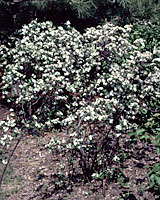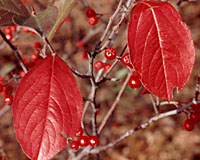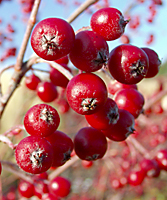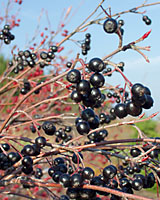Terry L. Ettinger Horticulture Consulting Services
Meeting The Needs Of Today With A Vision For The Future
Recommended Shrubs -
Chokeberry
 I try to squeeze as much visual value out of every square foot of
every garden or landscape that I design. To do that, I try to use
plants that offer multiple seasons of interest, are well adapted to
the conditions a site presents, and are resistant to insect pests
and diseases.
I try to squeeze as much visual value out of every square foot of
every garden or landscape that I design. To do that, I try to use
plants that offer multiple seasons of interest, are well adapted to
the conditions a site presents, and are resistant to insect pests
and diseases.
Near the very top of the list of plants that fit the above criteria are red and black chokeberry (Aronia arbutifolia and Aronia melanocarpa, respectively).
 Beginning
around the first of May, these six to eight foot-tall, multiple-stemmed shrubs will bear clusters of pure white, five-petaled flowers (at right, above)
for a week to ten days.
While the flowers arenít going to stop traffic, theyíre certainly attractive up close, especially as the white petals
provide a good backdrop for raspberry-colored anthers, at left.
Beginning
around the first of May, these six to eight foot-tall, multiple-stemmed shrubs will bear clusters of pure white, five-petaled flowers (at right, above)
for a week to ten days.
While the flowers arenít going to stop traffic, theyíre certainly attractive up close, especially as the white petals
provide a good backdrop for raspberry-colored anthers, at left.
During the summer, the shiny, olive-green leaves of these plants can provide a good backdrop for any and all perennials and small flowering shrubs in your garden.
 Itís in late summer through mid-winter, however, that these plants really stand out.
Itís in late summer through mid-winter, however, that these plants really stand out.
First, the leaves of red chokeberry turn fire engine-red with the onset of cool, autumn weather, at right. In fact, they easily rival the insanely popular Ė and therefore way over-planted burning bush Ė for outstanding fall foliage color! The fall leaf color of black chokeberry, meanwhile, tends to be less intense and less reliable from year to year.
 After the leaves drop, the ornamental interest of both plants remains strong as they bear dozens to over a hundred
clusters of BB-sized, bright red, at left, or deep purple to black fruit,
below right. In fact, itís been reported that mature black
chokeberry plants can produce over twenty pounds of fruit per year.
After the leaves drop, the ornamental interest of both plants remains strong as they bear dozens to over a hundred
clusters of BB-sized, bright red, at left, or deep purple to black fruit,
below right. In fact, itís been reported that mature black
chokeberry plants can produce over twenty pounds of fruit per year.
Besides the outstanding ornamental characteristics of these
plants throughout the year, they're also well-adapted to a wide
range of conditions - from damp to almost constantly wet soils, to
soils that are quite dry during the summer.
 They're also very tolerant of sweeping winter winds, so they can be used in
very exposed locations. And, while they flower and fruit best when
grown in full sun, they'll also do quite well in moderately shaded
locations.
They're also very tolerant of sweeping winter winds, so they can be used in
very exposed locations. And, while they flower and fruit best when
grown in full sun, they'll also do quite well in moderately shaded
locations.
About the only knock against chokeberry that I have is their tendency to be a bit "leggy," with their flowers, fruit and foliage borne right at the top of the plant. Fortunately, this is easy to hide with shorter shrubs, perennials and/or ornamental grasses. And, the tallest stems can always be selectively removed close to the ground immediately after the flowers fade in mid- to late May to reduce their overall height.